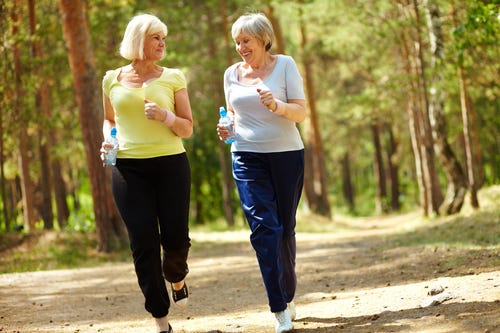
It’s going to be wicked hot today in Denver, rising to 95, which is nine degrees less and only marginally better than yesterday’s 104. Oy. I just came in from a two-mile run in my neighborhood. Right about the time I turn east, the 9:15 sun smacked me with all the force of Thor’s hammer. It’s harder to breathe in that kind of heat, but I chugged along, up the hill and down my shaded street, which blessedly, faces west. That gives us plenty of cool temps on the last leg home.
In my twenties, which is now four decades ago, I used to run all the time. A track enthusiast (please note I did not say STAR, just enthusiast, which means I was at best mediocre, but loved to run) in middle school and high school, I’d been a runner most of my life. However, I didn’t find that sport to help me with losing weight. Cycling did that, along with changing my eating habits from donuts to delectable fruit and veggies. But that’s another story.
Over the years, the specter of doing eight miles at a pop lost its sheen. I gave up running, especially after trying to do a paltry two miles at a friend’s house in Las Vegas in summer. I like running but I’m not big on self-flagellation.
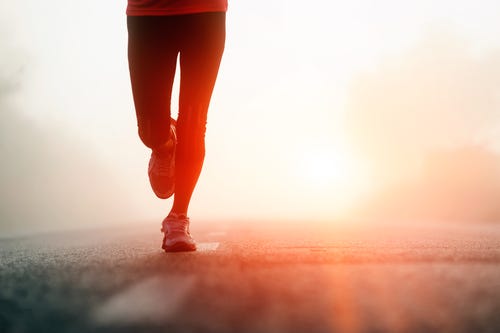
So I kinda quit. Especially after my last Blue Heeler (Queensland Blue Heeler Cattle Dog) passed away. The marathoners of the dog world, you’d better damned well run them or you won’t have a house or an apartment left. After I lost Coots, I switched to a host of other sports, and when asked, used the age old “it hurts my knees. It’s bad for my joints” argument.
I was wrong.
In fact, much the opposite is true. Running is better for us than walking, although given the option of doing nothing or because of infirmity or age or disabilities for example, walking is just fine, thank you very much. However, running does push us farther in many ways, at any age.
As a side note on walking, it’s essential to walk well. Barring the one leg shorter than the other challenge my 64-year-old endurance athlete friend Lisa dealt with for decades (the result of a car wreck), poor walking form can cause a host of hip-knee-ankle problems. It makes a LOT of sense, particularly if you are just beginning a walking regimen, to spend a little time and dime with a sports PT just to make sure your gait doesn’t cost you your mobility, or exacerbate underlying problems.
A tip for those who walk, but who do so with their faces buried in their phones: that head-down position is vicious for both your posture and your spine. Just ask any physical therapist or chiropractor (https://www.cbc.ca/news/health/text-neck-study-1.4071191). Parents who hand their kids a phone as toddlers are setting them up for a life time of neck problems. Not smart. But that’s why I call them Dumbphones.

I had constant knee issues for years, particularly after an overly-enthusiastic trainer pushed me very hard in a cross-training program. While we found the problem and minor surgery fixed it, it wasn’t until my sports chiropractor finally convinced me to invest in orthotics ($600, GASP) that were custom made that I got real relief. Each one of us has likely got some kind of gimp- especially after a Certain Age. Discovering and preparing for this before throwing yourself into a program is the best way to ensure that your exercise program not only is enjoyable but it doesn’t damage you. Since I only rarely wear heels any more, those orthotics go with me everywhere, and they have fundamentally changed my pain profile from HOLY SH*T to LET’S GO. Nobody is going to willingly walk, run or play with constant pain like that. Note, I said willingly. I had to walk, then run, as I rehabbed from knee surgery. It hurt like a bastard but that’s what got me on top of Kilimanjaro at sixty. It’s remarkable what a Big Hairy Ass Goal will do for getting you out and moving.
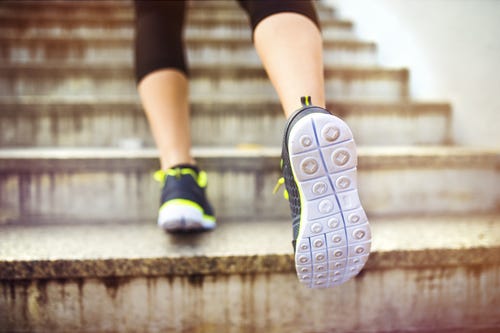
Back to Pounding the Pavement
This past year, before I had surgery on my rotator cuff in May, I began running again. Let me be specific. Ever since I got my knee fixed at 58, I have been jogging thousands of stairs at our local natural amphitheater, Red Rocks. That’s very different from running on the flat. I use the balls of my feet, and as a result I have a very different physical experience as well as the fact that I’m at 6200' and running both up and down hill. Steps were easier in some ways, and harder in others. Boy do I have a pair of lungs, and my endurance is remarkable. I LOVE stairs. They love us back, whether walking or running. Besides there are tons of puppers out there. Any time I get winded I can manufacture an easy break by hanging out with someone’s hound for a moment or two.
Running on the flat- depending on your foot strike, is a very different ball game. There’s plenty of research on running form (http://running.competitor.com/is-there-an-ideal-running-form), but the primary point is to listen to your body as you jog, run or sprint. If something hurts, especially if it persists, then see about it. Don’t push through it. Your body is carrying on a constant conversation with you and when it shrieks, pay attention. You may have a wobbly gait or pronate or supinate or something else that is causing you problems. Put the time in to ensure that you’re doing it right. Otherwise you end up injured, which is just the opposite of what you’re trying to accomplish.

The point of running- at any age- is to push the body to work. Your lungs suck in air, and your hard-working heart delivers oxygen and nutrients to your entire body. There are few easier ways to get healthy. As we age, we suffer from inevitable sarcopenia or muscle loss, which means that even if you do run, working out with weights in some form is essential. Body mass and strong bones (which are built both from proper diet as well as weight-bearing work) mean a more efficient immune system, faster healing, and overall vibrant health. Running or cycling, as good as they are, aren’t always enough. Our upper bodies also need work for balance, in more ways than one. While we are going to lose muscle mass no matter what, a balanced workout program slows that way, way down.
The other inevitable piece is lung capacity. According to the American Lung Association, you hit your peak between 20–25. After 35, our capacity slowly declines with age. There’s a very good reason we see so many old folks with an umbilical cord to an oxygen machine (like my mother). From their web article:
There are several natural body changes that happen as you get older that may cause a decline in lung capacity. Muscles like the diaphragm can get weaker. Lung tissue that helps keep your airways open can lose elasticity, which means your airways can get a little smaller. Also your rib cage bones can change and get smaller which leaves less room for your lungs to expand. Source: http://www.lung.org/lung-health-and-diseases/how-lungs-work/lung-capacity-and-aging.html.
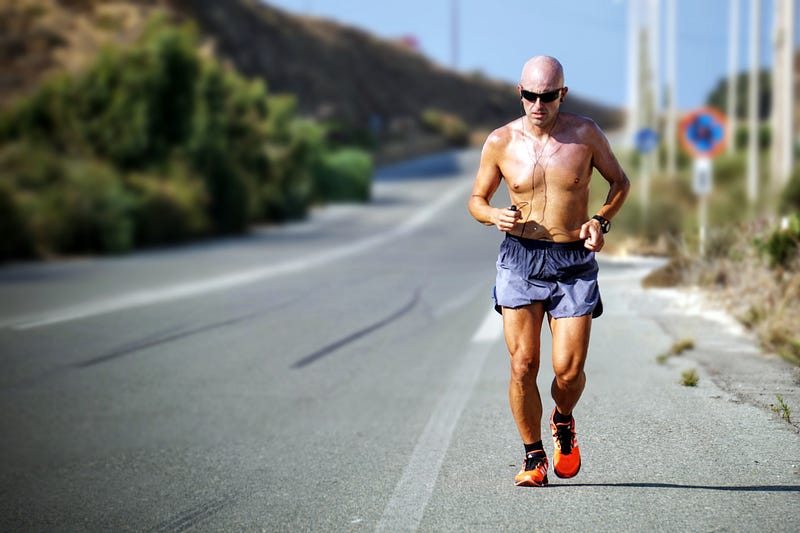
My argument is that just like sarcopenia, losing significant lung capacity is NOT inevitable. Through vigorous exercise we keep our lungs working at full capacity, which extends not only their life span but also continues to ensure that our hearts and circulatory systems function at their best our entire lives. Those of us who live at higher altitudes are already working a bit harder when we work out. That demand communicates to our lungs that we expect them to perform. And perform they do. Running does this better than walking, albeit if you’re hiking, it’s much the same thing. Gaining altitude is a right perfect way not only to enjoy luscious scenery but also to push our capacity.
Learning to run, which means how to hold our bodies, use our arms, perfect our foot strikes are all part of ensuring that our running experience is joyful. Outside Online penned an article about this (https://www.outsideonline.com/2187996/all-about-running). The article offers terrific exercises to get you ready. They look fun, especially if you have a floor mat or a nice cool green lawn (my back yard does NOT qualify). Taking the time to treat the body with respect before pounding the pavement- or concrete- or clay- or grass, each of which has a wholly different impact on our bodies as we run can mean the difference between falling in love with a sport we can do our entire lives, at any speed, and giving up shortly after starting.

At 65, I went back to running as soon as the weather allowed in my West Denver neighborhood this year. A dear friend admonished me that it would tear up my joints. That’s old, conventional wisdom. Hogwash. As in all things, it depends. Many factors go into that question from how heavy you are to how far you run to how fit you are to how well you run, which goes to ensuring that someone has watched and critiqued your gait. Not only that, the essential art of stretching, which not only goes a long way to prevent injury, but we aging athletes need to do a great deal more of anyway. Flexibility falters as we age unless we invite our muscles to stay lithe.
Truthfully, I’m much rather run 2400 steps at Red Rocks, which is about an hour, rather than three miles around my neighborhood. Both are hugely useful, fun and engaging. It’s highly unlikely I will do endurance running again. However I don’t know that. Some years ago after that last Vegas run I swore I was done with running forever.
Just as in the James Bond movie Never Say Never Again, It depends.
I was standing at the edge of my driveway about to start my walk, when my body simply demanded more. So I ran. Not at any impressive speed but enough to make me pant, sweat harder, and feel downright righteous when I made the other side of the driveway about forty minutes later.
Damn, I thought. That was a lot easier than I thought it would be.
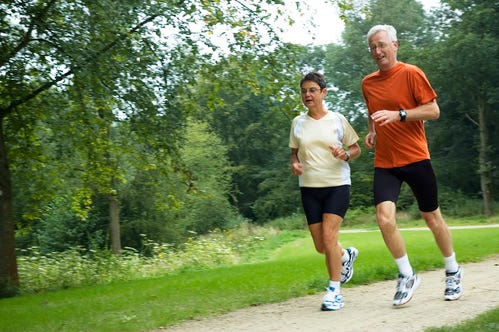
For many of us, precisely. It really is. When we shove aside conventional wisdom, which isn’t based on new science and what we really do know about the body as it ages, we can push a lot harder than we think. We don’t have to be marathoners. We just need to be moving.
When we stop moving, we start dying. To say the least, it’s one reason why I head out and run.
Comments powered by Talkyard.